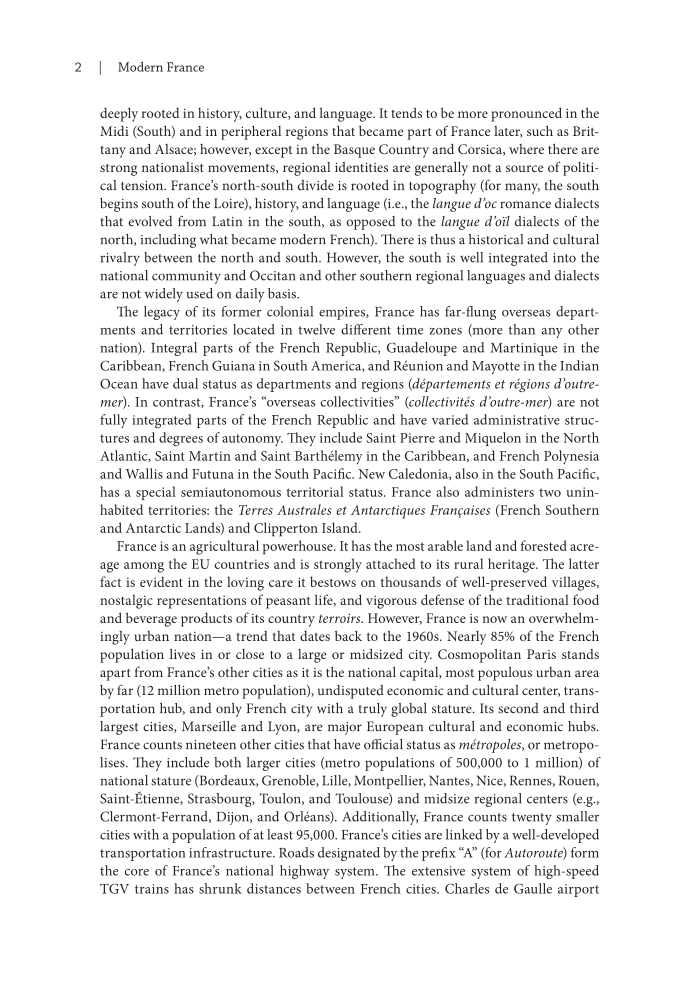2 | Modern France deeply rooted in history, culture, and language. It tends to be more pronounced in the Midi (South) and in peripheral regions that became part of France later, such as Brit- tany and Alsace however, except in the Basque Country and Corsica, where there are strong nationalist movements, regional identities are generally not a source of politi- cal tension. France’s north-south divide is rooted in topography (for many, the south begins south of the Loire), history, and language (i.e., the langue d’oc romance dialects that evolved from Latin in the south, as opposed to the langue d’oïl dialects of the north, including what became modern French). There is thus a historical and cultural rivalry between the north and south. However, the south is well integrated into the national community and Occitan and other southern regional languages and dialects are not widely used on daily basis. The legacy of its former colonial empires, France has far-flung overseas depart- ments and territories located in twelve different time zones (more than any other nation). Integral parts of the French Republic, Guadeloupe and Martinique in the Caribbean, French Guiana in South America, and Réunion and Mayotte in the Indian Ocean have dual status as departments and regions (départements et régions d’outre- mer). In contrast, France’s “overseas collectivities” (collectivités d’outre-mer) are not fully integrated parts of the French Republic and have varied administrative struc- tures and degrees of autonomy. They include Saint Pierre and Miquelon in the North Atlantic, Saint Martin and Saint Barthélemy in the Caribbean, and French Polynesia and Wallis and Futuna in the South Pacific. New Caledonia, also in the South Pacific, has a special semiautonomous territorial status. France also administers two unin- habited territories: the Terres Australes et Antarctiques Françaises (French Southern and Antarctic Lands) and Clipperton Island. France is an agricultural powerhouse. It has the most arable land and forested acre- age among the EU countries and is strongly attached to its rural heritage. The latter fact is evident in the loving care it bestows on thousands of well-preserved villages, nostalgic representations of peasant life, and vigorous defense of the traditional food and beverage products of its country terroirs. However, France is now an overwhelm- ingly urban nation—a trend that dates back to the 1960s. Nearly 85% of the French population lives in or close to a large or midsized city. Cosmopolitan Paris stands apart from France’s other cities as it is the national capital, most populous urban area by far (12 million metro population), undisputed economic and cultural center, trans- portation hub, and only French city with a truly global stature. Its second and third largest cities, Marseille and Lyon, are major European cultural and economic hubs. France counts nineteen other cities that have official status as métropoles, or metropo- lises. They include both larger cities (metro populations of 500,000 to 1 million) of national stature (Bordeaux, Grenoble, Lille, Montpellier, Nantes, Nice, Rennes, Rouen, Saint-Étienne, Strasbourg, Toulon, and Toulouse) and midsize regional centers (e.g., Clermont-Ferrand, Dijon, and Orléans). Additionally, France counts twenty smaller cities with a population of at least 95,000. France’s cities are linked by a well-developed transportation infrastructure. Roads designated by the prefix “A” (for Autoroute) form the core of France’s national highway system. The extensive system of high-speed TGV trains has shrunk distances between French cities. Charles de Gaulle airport
Document Details My Account Print multiple pages
Print
You have printed 0 times in the last 24 hours.
Your print count will reset on at .
You may print 0 more time(s) before then.
You may print a maximum of 0 pages at a time.




























































































































































































































































































































































































































































































































































